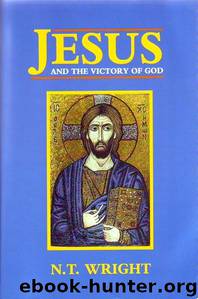Jesus and the Victory of God by N. T. Wright

Author:N. T. Wright
Language: eng
Format: mobi, epub, pdf
Tags: Biblical Studies, Religion, New Testament, Christianity
ISBN: 9780281047178
Publisher: Fortress Press
Published: 1997-02-07T00:00:00+00:00
130 Mt. 15:10–20/Mk. 7:14–23; cp. Thom. 14. For the symbol and its importance cf. NTPG 227–30, 237–41; and below, ch. 9. On the torturing of those who refused to eat unclean food cf. e.g. 2 Macc. 6:18–31; 7:1–42.
131 See NTPG ch. 10.
132 Mk. 4:11f./Mt. 13:13/Lk. 8:10. Cf. below, 236–8. Cf. too Mk. 10:10, on which see 000.
133 Mt. 24:15/Mk. 13:14. Cf. NTPG 390–6; 396–403.
134 cf. NTPG 434: the parables in Thom. have been shorn of their allegorical, and Israel-specific, elements, in order to conform to a different, radically Hellenized, worldview (contra Perrin 1976, 189). Thomas thus did for the parables in the second century what Jülicher, Dodd and Jeremias did in the twentieth, and perhaps for similar reasons, namely, the attempt to get away from their historical, and very Jewish, specificity. The irony of Jülicher’s position, which has been among the most influential this century, is this: he assumed that the parables were basically timeless teachings, which the early church then directed into some particular cultural setting, different from that of Jesus, by adding to them and variously ‘interpreting’ them. The opposite is likely to have been the case. The parables were originally highly ‘situational’, highly specific to Jesus’ unique ministry. The early church is likely to have made them more ‘timeless’, in order to ‘translate’ them for different situations. Jülicher and others, finding the specific and situational material non-universalizable and hence apparently useless, yet wanting to follow Jesus rather than the early church, have drawn the picture upside down, attributing the ‘usable’, generalized versions to Jesus, and the ‘situational’, and hence apparently useless, material to the early church. The question of how one might then ‘use’ Jesus’ highly context-specific work within a different context and culture must (as Dodd saw, 1961 [1935], ch. 7) be addressed as a whole, not picked off piecemeal, parable by parable.
135 cf. too Crossan 1992, 152: ‘It is a parable’s destiny to be interpreted and those interpretations will necessarily be diverse. When the diversity ceases, the parable is dead and the parabler is silent.’ (Cf. too Wilder 1982, 99f.) Without wishing to deny the polyvalence of all stories, we must insist that such radical postmodern pluralism is unhelpful within serious historiography.
136 The best examples of the parables as apocalyptic allegory are the wheat and the tares, the seed growing secretly, the sheep and the goats, etc.; and the clearest background may be found not only in Nathan’s parable (2 Sam. 12:1–15), which broke open David’s mindset with a vengeance, but also e.g. Ezek. 17:1–24; Dan. 7:1–27; Zech. 14, and others discussed in e.g. Drury 1985, ch. 1.
137 The parable which breaks this rule actually proves it. When Jesus told the ‘wicked tenants’, the time had come to abandon the earlier secrecy and force a showdown. Historically speaking, the parable belongs precisely with the action in the Temple, the moment when Jesus at last acted in a way that the authorities could not ignore. See below, ch. 11.
138 For a start, cf. Crossan 1973; NTPG ch.
Download
Jesus and the Victory of God by N. T. Wright.epub
Jesus and the Victory of God by N. T. Wright.pdf
This site does not store any files on its server. We only index and link to content provided by other sites. Please contact the content providers to delete copyright contents if any and email us, we'll remove relevant links or contents immediately.
Signature in the Cell: DNA and the Evidence for Intelligent Design by Stephen C. Meyer(3098)
The Secret Power of Speaking God's Word by Joyce Meyer(3067)
Real Sex by Lauren F. Winner(2986)
The Holy Spirit by Billy Graham(2914)
The Gnostic Gospels by Pagels Elaine(2496)
Jesus by Paul Johnson(2330)
Devil, The by Almond Philip C(2304)
23:27 by H. L. Roberts(2223)
The Nativity by Geza Vermes(2202)
Chosen by God by R. C. Sproul(2142)
All Things New by John Eldredge(2134)
Angels of God: The Bible, the Church and the Heavenly Hosts by Mike Aquilina(1944)
The Return of the Gods by Erich von Daniken(1913)
Angels by Billy Graham(1903)
Knowing God by J.I. Packer(1833)
Jesus of Nazareth by Joseph Ratzinger(1783)
The Gnostic Gospel of St. Thomas by Tau Malachi(1767)
Evidence of the Afterlife by Jeffrey Long(1760)
How To Be Born Again by Billy Graham(1757)
